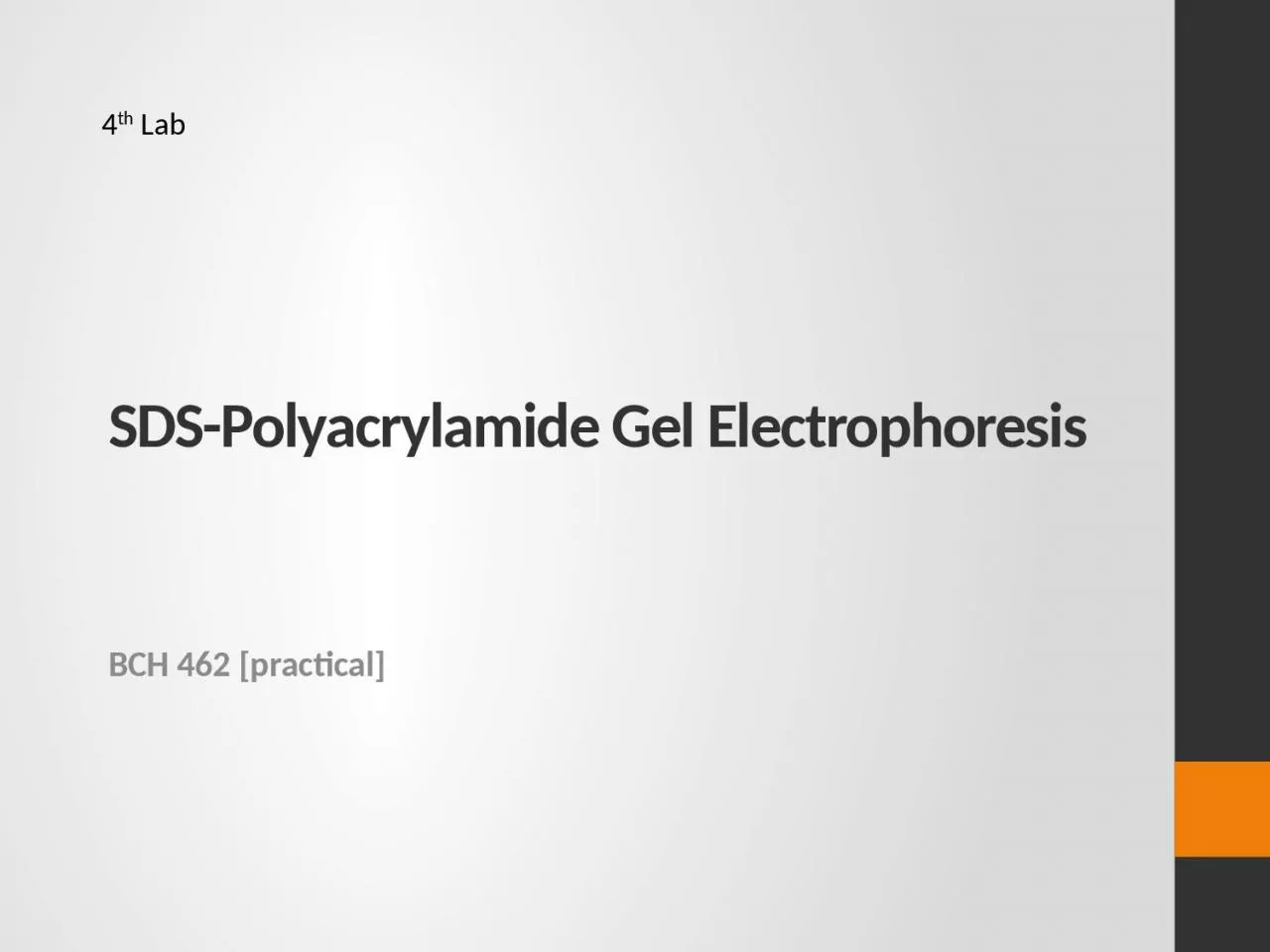

BCH 462 practical 4 th Lab Objectives Separation of protein fractions using SDSPAGE Sodium Dodecyl Sulfate Polyacrylamide gel Electrophoresis SDSPAGE is a technique widely used in biochemistry forensics genetics and molecular biology to separate and identify prot ID: 935532
Download Presentation The PPT/PDF document "SDS-Polyacrylamide Gel Electrophoresis" is the property of its rightful owner. Permission is granted to download and print the materials on this web site for personal, non-commercial use only, and to display it on your personal computer provided you do not modify the materials and that you retain all copyright notices contained in the materials. By downloading content from our website, you accept the terms of this agreement.
Slide1
SDS-Polyacrylamide Gel Electrophoresis
BCH 462 [practical]
4
th
Lab
Slide2Objectives:
-Separation of protein fractions using SDS-PAGE.
Slide3-Sodium
Dodecyl Sulfate-Polyacrylamide
gel Electrophoresis (SDS-PAGE
),
is a technique widely used in biochemistry ,forensics, genetics and molecular biology to separate and identify proteins
according to their molecular weight. -This method separates proteins based primarily on their molecular weights.
SDS-
Polyacrylamide
Gel Electrophoresis
Slide4-Sodium Dodecyl
Sulfate [SDS]: is a detergent which denature proteins by binding to the hydrophobic regions, all non-covalent bonds will disrupted and the proteins acquire a negative net charge.
-So, the proteins samples are having uniformed structure and charge
the separation will depend on their molecular weight only.
-Small proteins migrate faster through the gel under the influence of the applied electric field.The number of SDS molecules that bind is proportional to the size of the protein,
Thereby in the electrical field, protein molecules move towards the anode (+) and separated only according to their molecular weight.
Principle:
-A
Concurrent
treatment with a disulfide reducing agent such as β-
mercaptoethanol
or
DTT (
dithiothreitol
),
which further denatures the proteins by reducing disulfide linkages, thus overcoming some forms of tertiary protein folding, and breaking up quaternary protein structure
Slide5Slide6-
the proteins samples are having uniformed structure and charge
the separation will depend on their molecular weight only.
-
SDS-treated
proteins have very similar charge-to-mass ratios, and similar shapes. During PAGE, the rate of migration of SDS-treated proteins is effectively determined by molecular weight. -Small proteins migrate faster through the gel under the influence of the applied electric field, whereas large proteins are
successively
retarded, due to the sieving effect of the gels.
Slide7Polyacrylamide gel:
- The polyacrylamide gel is formed by co-polymerization of
acrylamide
and a cross-linking
By
N,N’-methylene-bis-acrylamide ” bis-acrylamide “.To polymerize the gel a system,
consisting of ammonium
persilfate (initiator) and tetramethylene ethylene
diamin (TEMED) is added[catalyst].
Slide8Slide9SDS-
Polyacrylamide Gel Electrophoresis
Slide10SDS-Polyacrylamide Gel Electrophoresis
preparations:1-Sample P
reparation :
-40µl
of protein sample + 10 µl of
disruption buffer
boil
the mixture 3minets at
99C.
̊
-SDS-PAGE
,
disruption
buffer
contain:
-
10
% (w/v) SDS
[?]
-1M
Tris
/
HCl
, pH 6.8
-Glycerol
[
?
]
-
β
-
Mercaptoethanol
[
?
]
-
Bromophenol
blue [
?
]
Slide112
- Polyacrylamide Gel Preparation :
Acrylamide
stock
should be prepared first :
-Cross-linked polyacrylamide gels are formed from the polymerisation of acrylamide monomer in the presence of smaller amounts of N,N’-methylene-bisacrylamide (normally referred to as ‘bis’-acrylamide).
A-Separation
gel
preparation:
Volume of stock solution required to
make 12%
polyacrylamide
gel
Stock solutions
2.0 ml
1.5 M
Tris
/
HCl, pH 8.8
3.2 ml
Acrylamide
stock
2.8 ml
Water
80 µl
10% SDS
100 µl
10% Ammonium
persulphate
(fresh)
20 µl
TEMED
Slide12B-Stacking
gel preparation:
Volume of stock solution required to
make 12%
polyacrylamide
gelStock solutions1.0 ml0.5M Tris/HCl
, pH6.8
1.0 mlAcrylamide
stock3.0 ml
Water
80 µl
10% SDS
100 µl
10% Ammonium
persulphate
(fresh)
20 µl
TEMED
Slide133-Running the gel using ,
Running buffer 1x pH
8.4
:
It is contain:
-Tris-HCl.-Glycine.-SDS.
4-
Stain the gel using staining buffer :
It is contain:
-Glacial
acetic acid
-Methanol
-
Coomassie
brilliant blue
250-R
5-
De-stain the gel using De-staining buffer:
It is contain:
-Glacial
acetic acid
-Methanol
Slide14Applications:
1. To detect the purity of the protein.
2. Determine of protein molecular weight.
http://www.youtube.com/watch?v=EDi_n_0NiF4
Slide15